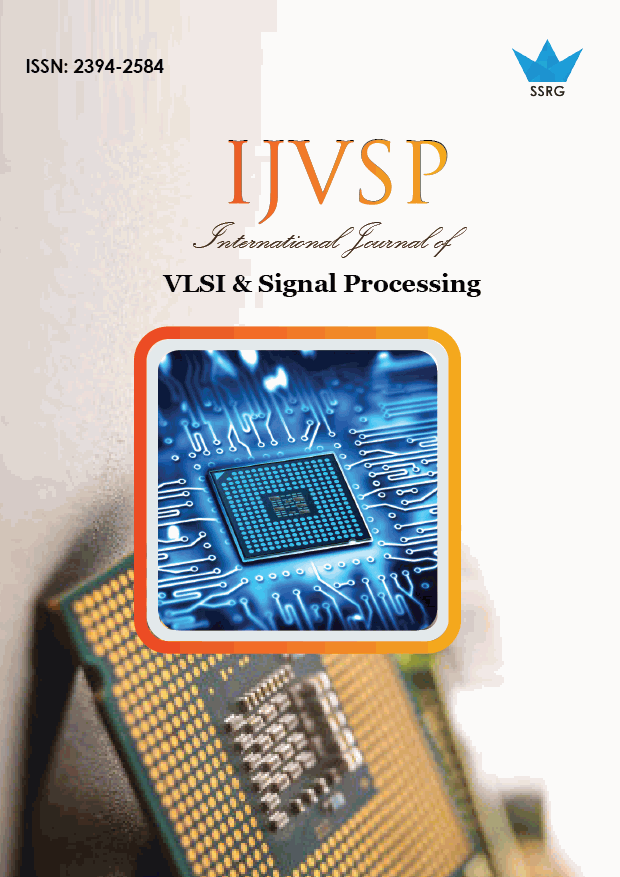Velocity regulator of AC motor with V/F controller

| International Journal of VLSI & Signal Processing |
| © 2016 by SSRG - IJVSP Journal |
| Volume 3 Issue 3 |
| Year of Publication : 2016 |
| Authors : Mrs.D.Sangavi and Mr.N.Rajagopal |
How to Cite?
Mrs.D.Sangavi and Mr.N.Rajagopal, "Velocity regulator of AC motor with V/F controller," SSRG International Journal of VLSI & Signal Processing, vol. 3, no. 3, pp. 22-26, 2016. Crossref, https://doi.org/10.14445/23942584/IJVSP-V3I3P104
Abstract:
A novel VLSI speed control method for induction motors using V/f controller that contributes almost zero steady-state speed error at any frequency and highly efficient torque.The present paper recommended stands alone control equipment for manufacturingbeginning motor speed control.This method leads to be able to change the speed of the motor by control the frequency and amplitude of the stator voltage of induction motor, the ratio of stator voltage to frequency have to be kept constant, which is called scalar control of AC motor drive. The Variable-speed drives are created when a motor is combined with a power electronicsconverter. By introducing variable speediness to the driven load, it is potential for the optimization of effectiveness of the entire structure and outcomes in greatest good organization gains. The speed is Control in AC Motors. AC motor drives are used in control applications such as the speediness of move forwards speeds, transmit or systems,engine tool speeds, and others that require variable speed. The altered methods of controlling AC motors, Control has verified to be the most flexible and accurate method. In this, PWM Inverters have been modelled and their output is fed to the AC Motor drives.
Keywords:
ACMotor, Voltage/frequency (V/f), PWM, Random Weight Change.
References:
[1]. Narn.E.Jyothsna, YarlagaddaYamini(2014), “Control of AC Motor using LabVIEW”, International Journal of Engineering Research & Technology (IJERT), Vol. 3 Issue 6, ISSN: 2278-0181.
[2]. Ravi Prakash, Prof. Rishi Kumar Singh, Rajeev RanjanKumar(2015), “Variable Voltage Variable Frequency Speed Control of Induction MotorUsing FPGA-Xilinx”, International Research Journal of Engineering and Technology (IRJET), Volume: 02 Issue: 03, e-ISSN: 2395 -0056, p-ISSN: 2395-0072.
[3]. Saritha M, Sofiya M, Arun S Dev, Atheena Francis, Aswathi R(2015) , “Speed Control And Monitoring System For Single Phase InductionMotor Using Labview With Motor Protection”, InternationalJournal Of Engineering Sciences & Research Technology, 2010, page no.277-280.
[4]. Tze-Fun Chan, Keli Shi, Applied Intelligent Control of Induction Motor Drives , John Wiley & Sons, 2011.
[5]. J.G. Ziegler and N.B. Nichols, Optimum settings for automatic controllers , Trans. ASME, 64, 1942, 759- 768.
[6]. Cohen, G.H., Coon, G.A. "Theoretical consideration of retarded control", Trans. ASME vol. 75, pp.827-834, 1953.
[7]. Johnson Curtis, "Process Control Instrumentation Technology", 7th ed., Prentice-Hall of India, New Delhi, 2003.
[8]. Aidan O'Dwyer," Handbook of PI and PID controller tuning rules", 3, illustrated, Imperial College Press, 2009
[9] NeelashettyKashappa and Ramesh Reddy K, “Performance of Voltage Source Multilevel Inverter-fedInduction Motor Drive using Simulink”, ARPN Journal of Engineering and Applied Sciences, vol. 6, No. 6, June2011.
[10] M.S.Aspalli, Veerendra.D, P.V.Hunagund, A Newgeneration VLSI approach for V/F control of Three-Phase Induction Motor, Proceedings of the InternationalConference on VLSI, Communication and Instrumentation, April7th-9th, 2011, Kottayam, India.
[11] Ning-Yi Dai and Man-Chung Wong “A FPGA-Based Generalized Pulse Width Modulator for Three-Leg Centre- Split and Four-Leg Voltage Source Inverters”, IEEETransactions On Power Electronics, Vol. 23, No. 3, pp.1472-1484, 2004.1, pp.674- 689, 1998.
[12] Madivalappa.B, M. S. Aspalli, “Speed Control ofThree Phase Induction Motor by Variable FrequencyDrive”, International Journal of Advanced Research inComputer Science and Software Engineering, pp.411-412, 2013
[13]. Linkens, D.A., & H.O. Nyongesa, ‗Genetic algorithms for fuzzy control„, IEE Proc. Control Theory Applications., Vol. 142, No. 3, pp.161-185.
[14]. Hang, C.C.; Sin, K.K., "On-line Auto-tuning Of PID Controllers Based on Cross Correlation," Industrial Electronics Society, IECON '88, Proceedings 14 Annual Conference of, vol.2, no., pp.441-446, 24-28 Oct 1988
[15]. Md.Shabiul Islam ,Nowshad Amin, MukterZaman , M.S.Bhuyan, Fuzzy based PID Controller using VHDL forTransportation Application, international journal of mathematical models and methods in applied sciences, Issue 2, Volume2, 2008.
[16]. Burton B. Kamran F. Harley R.G. Habetler T.G. Brooke M.A. Poddar R., Identification and control of induction motor stator currents using fast on-line random training of a neural network IEEE Transactions on Industry Applications 1997, Volume:33 , Issue: 3, Page(s): 697 – 704.
[17]. Da Zhang, Hui Li, Hybrid Stochastic and Neural Network Approach for Efficient FPGA Implementation of a FieldorientedInduction Motor Drive Controller , IEEE conference on Industry Applications 2006 41stIAS Annual Meeting. Volume: 4Publication Years: 2006, Page(s): 1752 – 1759.
[18]Dr. K. Ravichandrudu, P. SumanPramod Kumar, YN. Vijay Kumar, C. Praveen (2013), “3-Phase Ac Motor Monitoring and ParameterCalculation Using Lab VIEW and DAQ”, International Journal of Computational Engineering Research, Vol 03, Issue10, Issn 2250-3005.
[19] Dr. P.S. Bimbhra, “Electrical Machinery”, 7th Edition, Khanna Publishers, New Delhi, 2010.
[20] E. Ramprasath, P.Manojkumar(2015), “Modelling and Analysis of Induction Motor using Lab VIEW”, International Journal of Power Electronicsand Drive System (IJPEDS), Vol. 5, No. 3, pp. 344-354, ISSN: 2088-8694.

 10.14445/23942584/IJVSP-V3I3P104
10.14445/23942584/IJVSP-V3I3P104